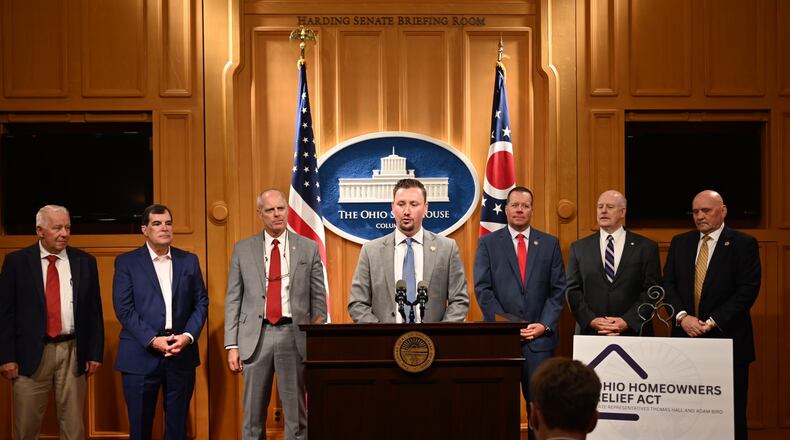The Ohio tax commissioner has recommended the following average residential property value increases for Southwest Ohio counties undergoing the triennial update: Butler - 42%, Clermont - 43%, Greene - 32% and Montgomery - 37%. These are countywide averages; not every home in these counties would see that increase.
If the legislation becomes law, the average hikes for Butler and Clermont counties would drop to 25% and 28% respectively, according to the Ohio Department of Taxation.
They didn’t calculate the other counties. Montgomery County Auditor Karl Keith said his estimate, using the parameters in the bill, would be an average 25% jump. He believes an accurate increase would be 34%.
Greene County Auditor David Graham estimates the increase for his taxpayers would be 22% if the bill passes. He said the number he is submitting to the state is around 28%.
“This is changing the state policy for good. This has broad implications not just for the 13 counties this year but also for the counties that are going to be up next year for their valuations,” Hall said. “It could be a pretty big shift that we’re taking to ensure that our property owners are protected from these outrageous property valuations, which right now is dictated by an unelected bureaucrat in Columbus.”
Keith said he doesn’t favor the bill.
“There are things with this bill that are not clear and I think will become very cumbersome and difficult to be implemented. It’s just going to cause more problems than it fixes,” he said.
Properties statewide are reappraised every six years, and property values are updated every third year based on sales data. The shifts are reflected on tax bills the following year. Auditor’s offices in 13 counties are in the process of the triennial update.
The law change would force the tax commissioner to equally weight all three years considered during the reappraisals. When Tax Commissioner Patricia Harris sent her recommended increases earlier this year, she placed heavy emphasis on 2022.
Lang said he will know by June 6 whether his amendment will stay in the budget bill, but he assumes it will. The House bill was introduced because that chamber already passed its budget; the local lawmakers didn’t want their colleagues to be blindsided when the Senate budget is returned to the House.
Reaction to the proposed fix
Gary Gudmundson, communications director for the Ohio Department of Taxation, told this news outlet they are willing work with the legislature.
“The Ohio Department of Taxation (ODT) is sympathetic to the issues residential property owners are facing with this unprecedented rise in property value in our state. We are happy to collaborate on any legislative proposal that would allow the Tax Commissioner to deviate from long-standing statutory methodology for valuing real property,” Gudmundson said. “As with any legislative change, we must carefully consider how that proposal would impact counties, schools, and other levying authorities statewide.”
The legislation was born out of a protest started by Butler County Commissioner Don Dixon, after he learned values could go as high a 24% — the initial estimate by Butler County Auditor Nancy Nix. He convened a summit of county and state leaders four weeks ago. It was Butler County Prosecutor Mike Gmoser’s idea to change the permissive word “may” in the state laws regarding reappraisals to “shall” so the tax commissioner’s discretion is removed.
“It’ll make it a lot easier of a financial burden on our taxpayers for next year,” Dixon said. “We’re still looking for longer-term solutions, but this is the quickest, best solution at this point.”
Keith said he has some reservations about the bill, especially since some auditors have already finished their work for the triennial, “the train has already left the station.” He agreed the legislature needs to do more.
“I think what we’re doing here is addressing the wrong side of the equation,” he said. “It’s not a value problem, it’s a tax problem and that’s been the case for a long, long time here in Ohio. The overreliance on property tax to fund government services is the real problem.”
Nix said the law change on the table “softens the blow” but agreed with Keith on that point.
“To fix it for taxpayers you have to have the revenues from somewhere else or you have to cut services. These are decisions for lawmakers to make and none of them will be easy or done quickly,” she said.
Greene County auditor Graham said “one of the things I like about the bill is it seems to put the auditor more in the driver’s seat with the commissioner’s office doing an overview.”
“County auditors have much better data in order to evaluate what values should be because we don’t look at it by taxing district, we look at it by neighborhood,” Graham said. “I live in the city of Xenia and you can’t say every property in the city of Xenia went up by the same percentage.”
He said this is a good “short term” solution but the three-year equal weighting could have a negative impact. Say for example a county had two years of 10% value increases and then a big drop in the third year, “people are going to have an increased value during a decline in the market, that’s going to be really tough to explain to taxpayers.”
“The long-term solution is going to take a lot more discussion,” Graham said.
House Majority Floor Leader Rep. Bill Seitz said he supports the three-year equally weighted rule, but will object if they try to keep changing it as the economy ebbs and flows.
“If you want a three-year average that’s a smoothing out process, that’s fine but you have to stick with it,” Seitz said. “We’re not just going to play heads I win tails you lose. Because ultimately the townships and the cities and schools and the special levies all need money. They don’t exist in a vacuum.”
The change in property value will have a direct impact on how much some taxpayers pay in taxes. School taxes in some — but not all — districts in southwest Ohio go up as taxable values increase, for example. Voted levies are not impacted the same way and are designed to collect a pre-set amount.
Dan Tierney, spokesman for Ohio Gov. Mike DeWine’s office, said they are “still reviewing potential statewide impacts of the newly unveiled proposals, including whether the proposals will have negative impacts outside of Southwest Ohio and whether the proposals would harm counties under different economic conditions that could occur in the future.”
About the Author

